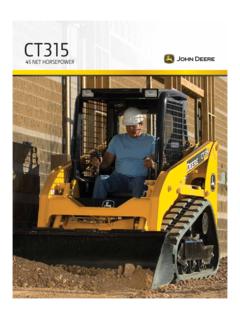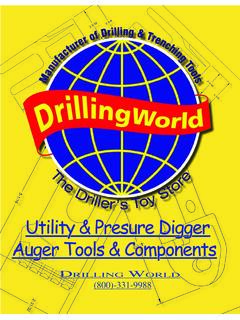Transcription of Your bucket tooth - Plasterer
1 your bucket tooth information source including product features, applications and specifications for the following product lines: Fanggs Deere Caterpillar replacement Hensley replacement Esco Conical replacement Esco Super . Esco Helilok /Vertalok . H & L replacement Rippers and scarifiers bucket tooth Basics tooth Performance and Wear Life tooth Performance and Wear Life Maximum performance and wear life are the two Design = Performance most important characteristics for replacement Strength = Wear Life teeth. Working with constant abrasive material places extreme demands on both design and The best designed tooth is always a compromise strength.
2 Of performance and wear life. Design is directly related to performance while strength is directly related to wear life. tooth Penetration Penetration is a key design consideration for all replacement teeth. To Achieve Good tooth Penetration To achieve good penetration, a tooth must have a 1. tooth must have sharp point. sharp point for initial ground entry. 2. Blade must taper gradually to reduce The tooth blade must taper gradually enough to resistance. reduce resistance to penetration and yet be thick 3. Blade must be thick enough to avoid enough to avoid breakage.
3 Breakage. The easier it is to penetrate the material the less horsepower is required for operation. tooth Centerline vs. Non-Centerline Design All centerline points are reversible to distribute wear and stay sharp. Non-centerline points can be rotated to balance wear patterns, but they cannot be flipped over to resharpen. Basics PI7262 Litho in (97-02) 1. bucket tooth Basics (Continued). tooth Installation tooth Breakage The job of a tooth retainer is to withstand tooth wear is expected, but tooth breakage impacts or shocks transmitted through the tooth under normal working conditions is not!
4 Without breaking or falling out. It must also tooth breakage in extreme conditions - very take up manufacturing tolerances so the tooth hard abrasive material where blasting, ripping, stays tight on the adapter. or air hammering might be more effective - The various types of hardware to install teeth should be expected. are covered in detail within each section. These The worst thing an operator can do is use the are some types of hardware or retainers used: bucket with missing teeth. A missing tooth exposes the adapter nose piece to wear. Any Flex Pin amount of worn metal from the adapter Spring Pin nosepiece leaves an open pocket between the Horizontal Pin and Split Washer adapter and the replaced tooth .
5 This open area Roll Pin allows the tooth to work back and forth. The Groove Pin adapter can no longer provide the support Crimp-On necessary to firmly attach the tooth to the Pin and Lock bucket . To find out if the nosepiece is the Quadrilok . reason for the tooth breakage, remove the tooth Pin and Plug tip. If the nosepiece is worn, the original shank tooth Wear or adapter should be replaced. It is a good idea to inspect bucket teeth, adapters, and the bucket condition daily. By determining wear patterns and rotating teeth, you can extend wear life and increase productivity which, in turn, provides you the greatest return for the money invested.
6 When using the right tooth and operating the bucket according to standard practice, a pattern will develop for normal wear. The tooth will maintain a profile similar to the original profile and it will continue to penetrate material quickly and easily. But even when using the right tooth , tooth wear is seldom even. Teeth that are near bucket corners generally wear fastest. And a bucket that is regularly loaded at an angle will show Both abnormal wear and breakage can be uneven wear on the loading side. Rotating prevented with the right choice of teeth.
7 Some teeth will help equalize the wear. suggestions include reducing the size and While teeth could assume the shape of a fist length of the point or switching to a forged or due to improper use of the bucket such as cast tooth when material becomes harder and scraping, dragging, or banging, it is most likely more abrasive. that the wrong teeth are being used for the application. Using the wrong teeth for the application takes more power to penetrate material and reduces productivity. Basics PI7262 Litho in (97-02) 2. bucket tooth Basics (Continued).
8 tooth Position FANGGS teeth have a curved shape to extend the contour of the bucket which results in a continuous flow of material to achieve maximum bucket fill. Reversing Fanggs teeth so that the curve of the tooth is opposite that of the bucket is not recommended. Teeth other than Fanggs installed on backhoe Forged and cast backhoe and excavator teeth and excavator buckets are mounted as can be reversed as shown in this drawing. The indicated in the above illustration. The flat area flat of the tooth faces away from the open side of the tooth faces the open part of the bucket .
9 Of the bucket . As you can see, tooth angle is In this position, tooth entry into the ground is less aggressive. Teeth can be mounted in this very aggressive. It allows the teeth to break position to avoid disturbing the trench floor. material for easier bucket loading. It is recommended that teeth be mounted in this It is not recommended that fabricated teeth be position for normal digging conditions. mounted in this reversed position. As the bucket is being loaded, material will wear thin the clip portion of the tooth . Eventually, tooth breakage will occur.
10 The clip is made of a softer metal and as a result is more susceptible to wear than the blade portion of the fabricated tooth . Basics PI7262 Litho in (97-02) 3. Adapter Installation Various retention methods between the adapter and bucket as well as the tooth and adapter are available. Check the condition of the bucket and repair as necessary before installing an adapter. Bolt-On Adapters 3. On hydrostatic crawler loaders, preheat the cutting edge holes (second set from When installing a new adapter, be sure the each end) to 400 F (204 C). cutting edge provides a firm mounting base.










